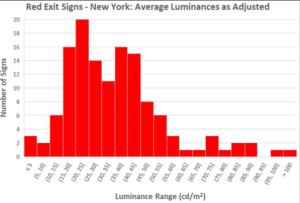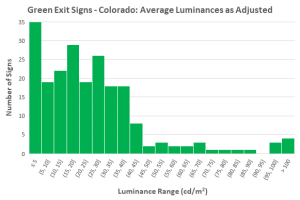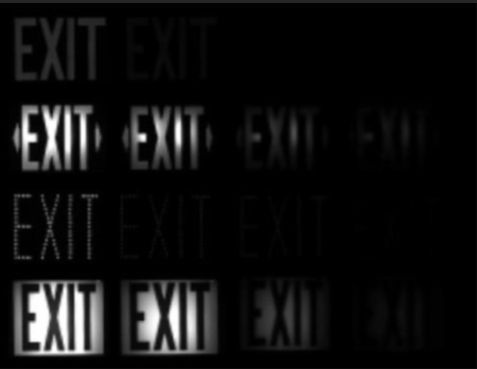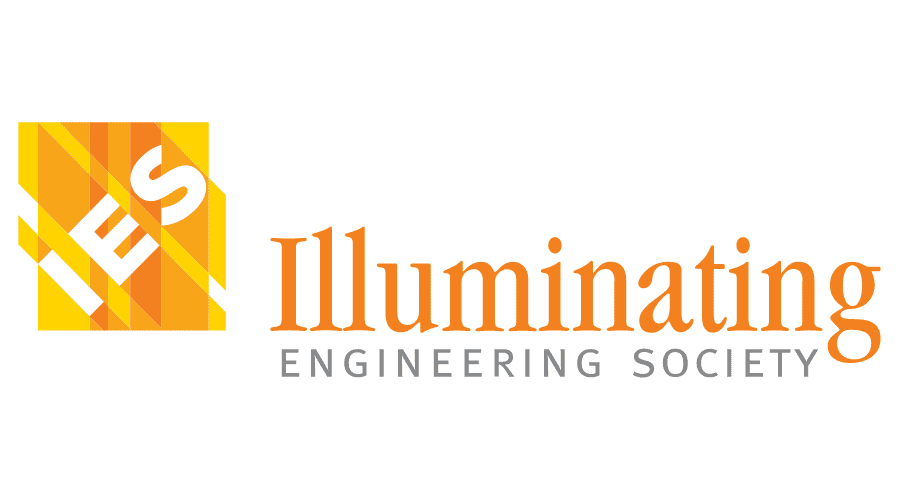Abstract
Of the millions of exit signs in the U.S., many if not most use light emitting diode (LED) sources. Standards for exit sign performance describe the performance of new signs but there are few if any data on their performance after installation. We discuss possible criteria for maintained performance of LED exit signs to help ensure visibility under smoky conditions, and present data on the luminances of red and green stencil-face LED exit signs in the field. These data may be useful to practitioners and policy-makers regarding the maintenance and monitoring of LED exit signs in commercial building spaces.
Why are exit signs important?
There are an estimated 43 million exit signs in the U.S., based on market data from the Department of Energy and assuming an annual increase of 1.5% (DOE, 2008). Most of these are in office and similar commercial spaces while others are in industrial spaces where dirt, higher temperatures and other factors could degrade exit sign performance. The de facto default lighting technologies used in nearly all exit signs since the late 1990s are light emitting diode (LED) sources (Conway and Bullough, 1999), due to their long life, energy efficiency, and ability to create red and green illumination (the most commonly required colors) without filtering. Although LED exit signs can be long lived, LEDs experience lumen depreciation over time (IES, 2021). Rather than experiencing total failure from “burn-out,” LED exit signs can grow dimmer (and hence less visible) over time while appearing to be operating normally, but data on the light output of in-service exit signs are practically non-existent.
How bright should exit signs be?
Several different standards for exit signs address their visibility. The National Fire Protection Association Life Safety Code (NFPA, 2015) requires exit signs to be legible from at least 100 feet away under clear conditions. The Life Safety Code refers to the Underwriters Laboratories standard, Emergency Lighting and Power Equipment (UL, 2008), which in turn stipulates that the minimum luminance of any illuminated portion of an exit sign should be at least 8.6 cd/m2. The UL standard defines 20 test points for assessing the luminance of a stencil face sign (having a luminous legend against an opaque background). Conway and Boyce (1997) reported that 95% of observers were able to identify the letters “EXIT” from 100 feet away in lighted and unlighted spaces (and again in clear conditions) when the average luminance of the illuminated portion of the sign was at least 15 cd/m2.

Obviously, it is important to be able to see an exit sign during a fire emergency when smoke might limit visibility compared to clear conditions (Figure 1). Using a mathematical model of light scattering in heavy smoke conditions, Boyce et al. (1994, 1995, 1998) calculated the distance from which different exit signs would be legible under those conditions (what they called the critical visibility distance). Figure 2 shows the calculated critical visibility distances in smoke, as a function of the legend’s average luminance under clear conditions. The legibility distance corresponding to an average legend luminance of 15 cd/m2, according to Figure 2, is 20 feet.

While a legibility distance of 20 feet is much shorter than the legibility distance of 100 feet in clear conditions for an average luminance of 15 cd/m2, there is some evidence that a minimum legibility distance of 20 feet under smoky conditions has merit. This distance corresponds to the distance an older adult can walk in 4.5 seconds, which is the 95th percentile decision-response time for older individuals (Olson, 1989). It is also the minimum legibility distance required by the Federal Aviation.
Administration (FAA, 2013) for airport wayfinding signage used by passengers who may be rushing to a gate to catch a flight. Thus, an average luminance of 15 cd/m2 seems sufficient to provide people with enough time to make a decision about where they might choose to go while making an emergency exit under smoky conditions. In our further discussion, we use an average luminance of 15 cd/m2 of the legend of a stencil face sign as what we believe to be a reasonable indicator of adequate exit sign luminance.
How should LED exit signs be measured in the field?
To begin to understand how many installed LED exit signs produce an average luminance of 15 cd/m2, we first developed a procedure for measuring LED exit sign performance in the field. Certainly, measuring the luminance of all 20 test points stipulated by UL (2008) would be cumbersome. We observed that almost all LED stencil face exit signs had legends that were very uniform, so a single luminance measurement for each letter was made (Figure 3) using a hand-held luminance meter with an aperture size of 0.33o. This aperture size permitted an observer to easily measure within the letter stroke size from 10 to 20 feet away.

Since the ambient lighting in a space contributes to the luminance of an exit sign legend, the vertical illuminance falling on the sign (Figure 4) was also measured. Laboratory measurements under different ambient light levels (from 4100 K fluorescent illumination) on an exit sign confirmed that for red signs, an increase in the illuminance on the sign of 1 lux corresponded to an increase in the legend’s luminance by 0.093 cd/m2. For green signs the increase was 0.119 cd/m2. Knowing the vertical illuminance on a red or green exit sign, it was then possible to subtract the luminance contribution from the ambient lighting in a space to estimate the luminance produced by the sign in otherwise dark conditions. It is important to be able to quantify this amount because it is not always possible to switch off all lighting in a space (especially one with daylighting) to measure an exit sign’s luminance.

What were the luminances of measured LED exit signs?
A research team in New York State (from the Mount Sinai Light and Health Research Center) used the procedure we developed to measure the average legend luminances of 132 red LED exit signs, and another team in Colorado (from Colorado Lighting, Inc.) measured 217 green LED exit signs. We realize that a few hundred signs is only a minute fraction of the tens of millions of exit signs in the field, but we had to start somewhere!


Figure 5 shows a histogram of exit sign legend luminances for the red LED stencil face exit signs measured in New York State, and Figure 6 shows a histogram for the green LED signs measured in Colorado. Both histograms show a large spread in the measured luminances – the average luminances range from less than 5 cd/m2 to greater than 100 cd/m2. For the red signs, 8% of them had an average legend luminance below 15 cd/m2, and 35% of the green signs averaged below this value. Out of the total of 349 LED exit signs, nearly 25% had an average luminance below 15 cd/m2.
Is there a problem and if so, are there solutions?
If the sample of signs we measured is representative, there could be millions of LED exit signs in the built environment with average legend luminances below 15 cd/m2. We want to reiterate that there is not currently any legal requirement that an exit sign in a building have an average legend luminance that is at least this value, but this seems like a useful criterion for the usefulness of an exit sign in smoky conditions. Regardless of the specific criteria one chooses for the visual effectiveness of exit signs, data like those in Figures 5 and 6 can be useful in understanding how many signs do or do not meet those criteria.
What is clear is that the long operating lives of LEDs presents both advantages and disadvantages for applications like exit signs. On the one hand, LED exit signs are less likely to simply “burn out” and be completely off than signs using incandescent or fluorescent sources. On the other hand, building maintenance personnel might assume that any exit sign that appears to be lighted is providing a useful amount of light even in smoky conditions when it might not be. This is more important than ever because the latest Life Safety Code has done away with monthly exit sign visual inspections.
One key piece of information still missing from our study is any information on the age of the measured signs. Because exit signs are part of a building’s safety infrastructure, few landlords.
would be willing to allow researchers to pull the signs down in hopes of finding a label stating when the sign was manufactured. Our informal discussions with several building owners suggested as well that few of them keep records of when signs were installed. Having that information could help lead to some estimates for how long an LED exit sign might take for its luminance to fall below some criterion value.
There could be technical solutions for alerting a building owner when an exit sign has reached a luminance value that might not be as effective as desired, such as a photosensor that records light output of the sign. It would also be desirable to have further information about different sign types in different locations in addition to the limited sample we measured. We are hopeful that by sharing these initial results on the status of LED exit signs, the lighting and safety communities will be spurred to devise improved ways to ensure that occupants have a safe means of leaving their buildings during emergency situations.
Acknowledgments
We gratefully acknowledge the financial support from the Jim H. McClung Lighting Research Foundation in conducting this research, under the direction of Terry McGowan. We also acknowledge the partnership of the interNational Association of Lighting Management Companies (NALMCO) in carrying out the study. Mariana Figueiro, Nicholas Skinner and Howard Ohlhous from the Mount Sinai Light and Health Research Center; Jean Paul Freyssinier, Ernest Katzwinkel and Kevin Surman from Rensselaer Polytechnic Institute; Chris Frank, Scot Kelley, and Shaun Rondinelli from Colorado Lighting, Inc., and Craig DiLouie from ZING Communications all made helpful contributions to this study. The full project report can be found online at: http://tinyurl.com/exitsign2021.
References
Boyce PR, Bierman A, O’Rourke C. 1994, 1995, 1998. Specifier Reports and Supplements: Exit Signs. Troy, NY: Lighting Research Center, Rensselaer Polytechnic Institute.
Conway KM, Boyce PR. 1997. Expanding the market for visually effective, highly efficient exit signs. Proceedings of Right Light, Volume 2.
Conway KM, Bullough JD. 1999. Will LEDs transform traffic signals as they did exit signs? Proceedings of the IESNA Annual Conference (pp. 1-9), New Orleans, LA, August 9-11.
Department of Energy (DOE). 2008. Energy Savings Estimates of Light Emitting Diodes in Niche Applications. Washington, DC: Department of Energy.
Federal Aviation Administration. 2013. Airport Signing and Graphics, FAA AC 150/5360-12F. Washington, DC: Federal Aviation Administration.
Illuminating Engineering Society (IES). 2021. Measuring Maintenance of Light Output Characteristics of Solid-State Light Sources, ANSI/IES LM-80-21. New York, NY: Illuminating Engineering Society.
National Fire Protection Association (NFPA). 2015. Life Safety Code, NFPA 101. Quincy, MA: National Fire Protection Association.
Olson PL. 1989. Driver perception response time. SAE Transactions Journal of Passenger Cars 98(6): 851-861.
Underwriters Laboratories. 2008. Emergency Lighting and Power Equipment, UL 924. Northbrook, IL: Underwriters Laboratories.







